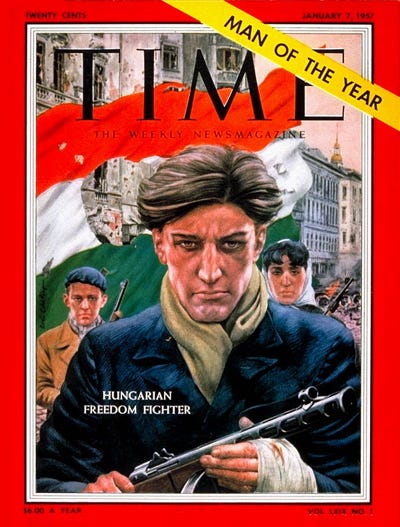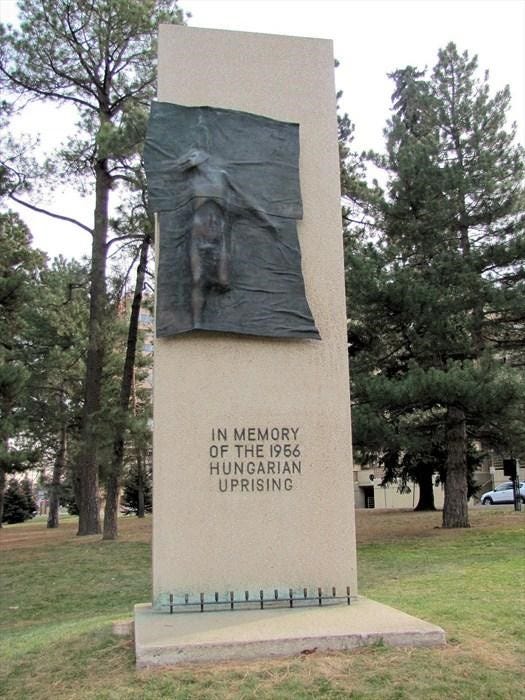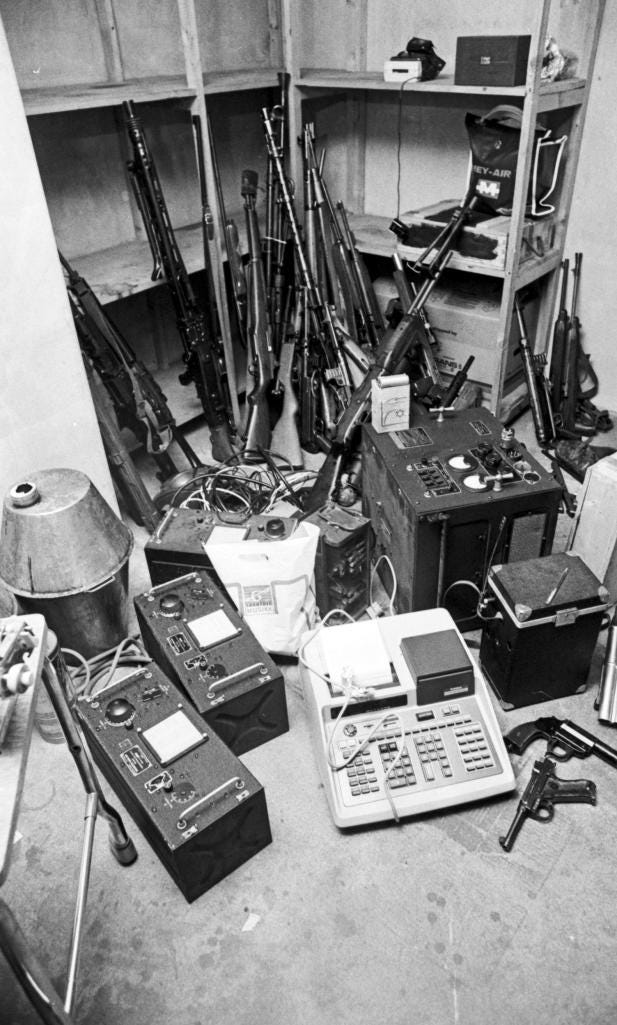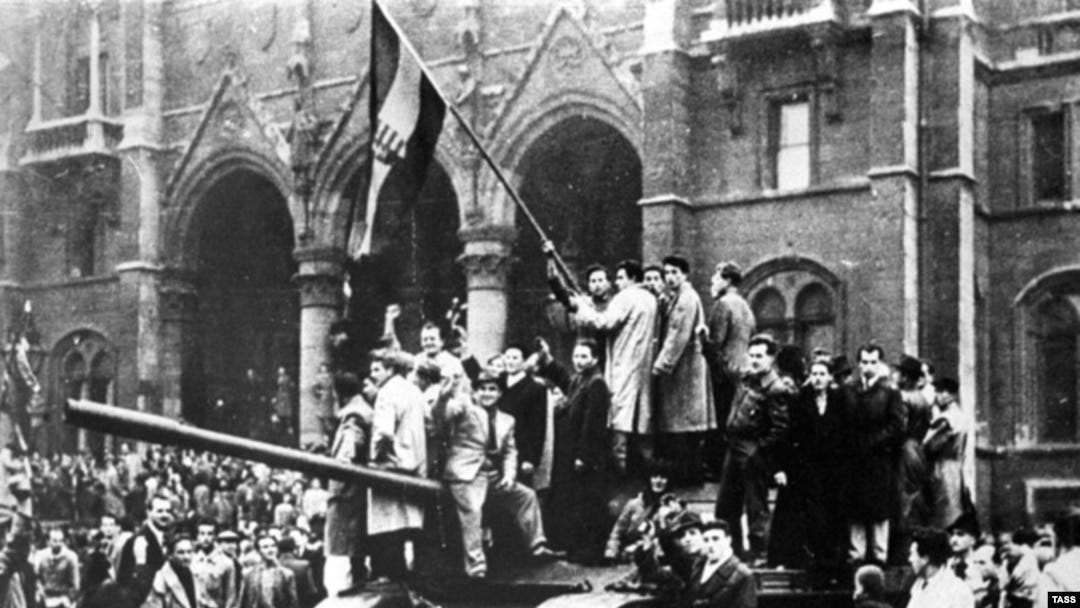JFK Files Reveal CIA Role in the 1956 Hungarian Uprising
The tankies were right.
If you’ve discussed politics on social media, you’ve probably heard the term “tankie.” Ostensibly a pejorative against authoritarian communists, the term is commonly used against anyone who disputes the U.S. State Department. For example, I’ve been called a tankie for saying sanctions are partially to blame for Venezuela’s hardship and stating China is less imperialist than America. Though the current usage is vague, “tankie” was initially used to describe the Communist Party of Great Britain, which supported Nikita Khrushchev's sending the Red Army to put down the 1956 Hungarian Uprising.
While the Hungarian Uprising lasted less than two weeks, it became a powerful propaganda weapon for the capitalist West at the height of the Cold War. The rebels were upheld as an example of the ordinary people, willing to risk life and limb for American-style democracy*, being crushed by the evil iron fist of communism. TIME named the Hungarian Freedom Fighter 1956’s Man of the Year, and President Eisenhower called the uprising “a renewed expression of the intense desire for freedom long held by the Hungarian people.”1 There’s even a Hungarian Freedom Park here in Denver, and I’d bet many similar monuments are spread throughout the United States.
However, many communists and non-communists alike have long doubted Washington’s portrayal of the events that took place in Budapest in the Fall of 1956. And as the recently-released JFK files show, the naysayers were onto something.


Like the rest of the Soviet Union, the 1950s were precarious for Hungary. Stalin died in 1953, and the new Soviet leader, Nikita Khrushchev, condemned his predecessor and implemented a policy of de-Stalinization.2 With the communist world taking a new direction, the Hungarian Working People’s Party, the Moscow-aligned communist party, replaced Stalinist leader Mátyás Rákosi with the more moderate Ernő Gerő. Wanting to align with Moscow’s new agenda, Gerő paroled several prisoners accused of treason. One of them was Béla Király, who played a key role in the coming events.
A major general in the Hungarian Army, Király fought for the Nazis during World War II. He oversaw a battalion of imprisoned Jewish slave laborers and later commanded the Axis defense of Kőszeg. Following the battle, Király was captured, released, and repositioned himself as a communist. Despite his new affiliation, Király never abandoned his fascist beliefs. After the war, he married into the family of Gyula Gömbös, the fascist Hungarian premier who spent the 1930s attempting to recreate Hungary in the model of Hitler’s Germany.3 In the early 1950s, Király was arrested on espionage charges. He spent five years in prison before receiving the aforementioned pardon in September 1956. On October 23rd, a student group overtook the Hungarian public radio station and broadcasted a list of sixteen demands to the government, including making reformist communist Imre Nagy as prime minister. Security guards seized the students, and a protest swelled outside to support them. Upon hearing the news, Béla Király rushed to organize the protestors into a military fighting force. As he told the French press years later, “In twenty-four hours, I created a professional military staff” from the rabble.4
Király’s newfound army fought bloody street battles against the pro-Soviet faction comprised of Hungarian troops, policemen, and civilians. Moscow sent Red Army troops and tanks (hence the name “tankie”) into Budapest and agreed to students’ demands to let Imre Nagy run the government. Four days later, on October 28th, Nagy announced a ceasefire, and the Soviets withdrew. Initially, large segments of the Hungarian Working People’s Party had supported the rebellion and Nagy’s government. To match its new reformist communist identity, the Party reconfigured as the Hungarian Socialist Workers’ Party (SWP) on November 1st. It’s essential to identify the Party kept its Marxist-Leninist ideology and was not calling for an end to socialism.
For a moment, it appeared peace would hold. Kruschev vetoed a suggestion from hardliners to crush the rebellion by force, stating a political solution could be reached as the rebels were protesting economic conditions, not the communist ideology.5 But on November 4th, Nagy crossed Moscow’s red line. He intended for Hungary to leave the Warsaw Pact, the communist world’s version of NATO. The new SWP was aghast. Stating Nagy was not reflecting their positions, the Party asked the Soviets to help remove him.6 With higher stakes on the table, Khrushchev agreed to the military option. Over the next eight days, Béla Király’s rebel army, which supported Nagy’s drive to leave the Warsaw Pact, fought against the Soviets and their allied Hungarians in the streets of Budapest. By the time the Soviets reestablished control a week later, approximately three thousand Hungarians and seven hundred Soviet troops were dead. An estimated two hundred thousand civilians fled the fighting as refugees, with most going to Austria.7 Béla Király fled to the United States, where he spent the rest of his life crusading against communism and teaching military history at Brooklyn College. Funny how those pesky Nazis always managed to worm their way back into polite society!
It had long been theorized by segments of the international left that the rebellion was a Western intelligence operation. In 1996, journalist Michael Smith published a book where MI6 officers, a branch of British intelligence, admitted they trained and armed Király’s fighters.8 The officer told Smith:
"We were taking them [fighters] into the mountains and giving them a crash course. I would be told to pick somebody up from a street corner at night in the pouring rain. Graz was our staging point. Then, after we'd trained them — explosives, weapons training — I took them back. We were training the agents for the uprising."
The source also admitted the rebels were armed with American and British weapons, stashed throughout Europe. These were likely part of the infamous Operation Gladio, a plan to arm anti-communists (mostly former Nazis) throughout Europe.

Outside of declassified admissions, the sequence of events leading to the Hungarian Uprising was always bizarre. As a Nazi turned communist turned anti-communist, Béla Király is the ideal target for a CIA recruiter: someone keen to flip sides for a suitcase cash and promises of a comfortable life in New York City. Additionally, the ruling communist party reorganized to support the rebellion, but when Imre Nagy went beyond their expectations, they felt betrayed and asked the Soviets to re-intervene. To me, this indicates there were forces in the anti-Soviet movement pushing the rebellion further than originally intended. Nagy admitted such factions were active during his October 28th radio speech.
“The Government condemns the viewpoints according to which the present formidable movement is a counterrevolution [against socialism]. Without doubt, as always happens at times of great popular movements, this movement too was used by criminal elements to compromise it and commit common criminal acts. It is also a fact that reactionary and counterrevolutionary elements had penetrated into the movement with the aim of overthrowing the popular democratic regime.”9
It also bears remembering exiting the Warsaw Pact was not one of the sixteen demands of the student protestors. While they required a “re-adjustment” to Hungarian-Soviet relations and accountability for Stalin-era crimes, the notion of ending the Soviet Union’s defensive pact appears to have arisen from thin air sometime between October 23rd and November 1st. Thanks to the newly released JFK files, we have additional evidence this extreme goal was injected into rebellion by Uncle Sam.

As you might have heard, the Trump Administration declassified eighty thousand pages of previously withheld documents on the assassination of President John F. Kennedy. (If you want to learn more about that event, I suggest following JFK Facts.) Brought forward by the Mary Ferrell Foundation, one document shows the CIA’s role in the Hungarian rebellion.10
The first, pictured below, was a previously released but redacted file. It mentions Béla Király as the president of the Hungarian Freedom Fighters Federation, Inc., a continuation of the rebel movement set up by the CIA after 1956.11 The document, focused on Cuba, suggests that Király is a good person for the CIA’s anti-Castro organizations to meet with. You’ll notice the white-out labeled “24” that removes the brackets following “The Hungarian Freedom Fighters were…” Also notice how the CIA differentiates between Hungarian Freedom Fighters Federation Inc, which was set up after Béla Királ fled to the U.S., and the Hungarian Freedom Fighters, the name for Királ’s 1956 contingent.
Here’s the newly released, un-redacted version.
It reads:
The Hungarian Freedom Fighters were Agency sponsored.
The “Agency” in question was, of course, the Central Intelligence Agency. In the context of the JFK assassination, the CIA was suggesting anti-Castro groups meet with Béla Király, likely to replicate the Hungarian uprising in Cuba to oust the communist government.
Undoubtedly, some will downplay this revelation and claim the CIA’s role in the Hungarian Rebellion was minor, insisting it was always a popular movement against Soviet-style communism. As has been since 1956, I’ll be called a tankie for suggesting the American foreign policy establishment was 100% honest and weren’t the pristine Good Guys of History. Oh well. It won’t be the first time and it won’t be the last.
In my opinion, there is more than enough circumstantial evidence to conclude beyond a reasonable doubt that the Central Intelligence Agency encouraged, if not instigated, the bloody fighting that swept through Budapest in 1956. I don’t doubt the students and protestors shared Nikita Kruschev’s desire for de-Stalinization. But as that movement went from a demand to readjust the Hungary-Soviet relationship to outright destruction of the Soviet Union’s defensive pact in less than two weeks, there was obviously a secondary, driving force that compelled Nagy to go further. As these documents admit, Béla Király and the broader combative force were supported, trained , and armed by the CIA and MI6; you don’t need to be a genius to figure out who was pushing the Hungarian Uprising to move from civil protest to alignment with Washington D.C.’s geopolitical goals.
Thank you for reading! If you found this article interesting, subscribe so future ones are delivered to your inbox. As always, I would appreciate it if you ❤️ this article, as it helps my work stand out in Substack’s algorithm.
In Solidarity — Joe
https://www.cvce.eu/en/obj/statement_by_dwight_d_eisenhower_on_the_hungarian_uprising_25_october_1956-en-75d790be-d6b8-4f17-b4ac-de498fd25b4d.html
https://www.marxists.org/archive/khrushchev/1956/02/24.htm
https://www.britannica.com/biography/Gyula-Gombos
https://www.nytimes.com/2009/07/08/world/europe/08kiraly.html
https://nsarchive2.gwu.edu/NSAEBB/NSAEBB76/doc5.pdf
https://www.arcanum.com/hu/online-kiadvanyok/TenyekKonyve-tenyek-konyve-1/1988-2/magyarorszag-3C8C/a-magyar-szocialista-munkaspart-mszmp-42CE/
https://www.bbc.co.uk/bitesize/guides/z4mrd2p/revision/3
https://www.the-independent.com/news/world/mi6-trained-rebels-to-fight-soviets-in-hungarian-revolt-1359599.html
https://worldjpn.net/documents/texts/docs/19561028.S1E.html
https://www.maryferrell.org/pages/Main_Page.html
https://www.cia.gov/readingroom/docs/CIA-RDP82-00046R000200350006-5.pdf








The CIA is a transnational crime syndicate.
Damn those tankies. They're right too often for our own good. They were right about Obama, and now, at long last, they are proven right about Hungary in 1956.
The irony is that Khrushchev would have allowed a lot of the reforms the Hungarian protesters wanted, and the thing that made it a bridge too far was the CIA. It's almost as if they didn't want the Soviets to do any reforms that might actually help their system survive.